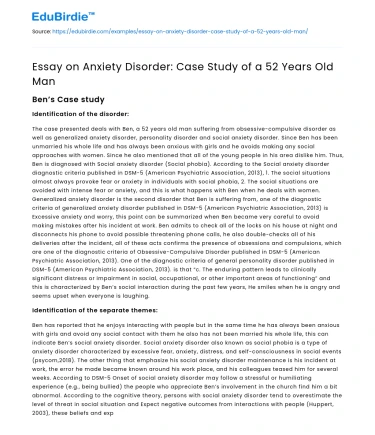Introduction
Anxiety disorders are characterized by excessive fear or worry that interferes with daily life. They are among the most common mental health disorders, affecting millions worldwide. This essay explores the case of a 52-year-old man, referred to as Mr. Smith, who has been diagnosed with generalized anxiety disorder (GAD). By examining his experiences, treatment options, and coping mechanisms, we aim to shed light on the complexities of managing anxiety in middle-aged individuals. According to the American Psychiatric Association, GAD affects approximately 3.1% of the U.S. population in any given year (American Psychiatric Association, 2013). Understanding the nuances of such disorders in middle age can provide valuable insights into effective interventions and support mechanisms.
Case Analysis: Symptoms and Diagnosis
Mr. Smith, a 52-year-old accountant, began experiencing pervasive anxiety several years ago, which gradually intensified to disrupt his professional and personal life. His symptoms included chronic worry, restlessness, fatigue, and difficulty concentrating. These symptoms align with the diagnostic criteria for generalized anxiety disorder (GAD) as outlined in the DSM-5 (American Psychiatric Association, 2013). Mr. Smith’s anxiety was exacerbated by stressors such as job pressures and familial responsibilities, leading to further complications such as insomnia and irritability.
Save your time!
We can take care of your essay
- Proper editing and formatting
- Free revision, title page, and bibliography
- Flexible prices and money-back guarantee
Clinical assessment revealed that Mr. Smith’s anxiety was not limited to specific events but was instead a persistent and uncontrollable worry about various aspects of life. This case illustrates the typical presentation of GAD, where individuals experience anxiety that is disproportionate to the actual situation. According to a study by Kessler et al. (2005), GAD is often underdiagnosed in middle-aged men due to societal expectations of stoicism and resilience, which may prevent individuals from seeking help. This highlights the importance of awareness and early intervention to prevent the escalation of symptoms.
Furthermore, Mr. Smith's case underscores the need for comprehensive diagnostic procedures that consider both psychological and physiological factors. Studies have shown that middle-aged individuals with anxiety disorders often experience co-morbid conditions such as depression and cardiovascular issues, complicating the diagnostic process (Beekman et al., 2000). Therefore, a holistic approach in assessment is crucial to identify the root causes and tailor treatment accordingly.
Treatment Approaches: Therapy and Medication
Upon diagnosis, Mr. Smith was presented with a range of treatment options, including cognitive-behavioral therapy (CBT) and pharmacotherapy. CBT is a widely recognized therapeutic approach that focuses on altering negative thought patterns and behaviors associated with anxiety. According to Hofmann et al. (2012), CBT is effective in reducing symptoms of GAD and improving overall functioning. In Mr. Smith’s case, regular CBT sessions helped him develop coping strategies and challenge irrational beliefs contributing to his anxiety.
In conjunction with therapy, Mr. Smith was prescribed selective serotonin reuptake inhibitors (SSRIs), a class of medications commonly used to treat anxiety disorders. SSRIs work by increasing serotonin levels in the brain, which can help alleviate anxiety symptoms. While effective, the use of medication in treating anxiety disorders is not without controversy. Critics argue that medication may lead to dependency and fail to address the underlying causes of anxiety (Baldwin et al., 2011). However, in Mr. Smith's case, the combination of CBT and medication provided significant relief and enabled him to resume normal activities.
This treatment approach exemplifies the importance of a personalized plan that considers the unique needs and circumstances of each patient. The interplay of therapy and medication can offer a balanced approach, addressing both the psychological and biochemical aspects of anxiety. Importantly, ongoing evaluation and adjustment of treatment are essential to ensure sustained improvement and prevent relapse.
Coping Mechanisms and Long-term Management
Beyond formal treatment, Mr. Smith adopted several coping mechanisms to manage his anxiety in the long term. These included mindfulness practices, regular physical exercise, and a structured daily routine. Mindfulness, in particular, has gained recognition for its role in reducing anxiety by promoting present-moment awareness and emotional regulation. A meta-analysis by Khoury et al. (2013) supports the efficacy of mindfulness-based interventions in reducing anxiety symptoms.
Physical exercise is another effective strategy, as it has been shown to decrease stress hormones and increase endorphins, contributing to improved mood and reduced anxiety (Salmon, 2001). Mr. Smith incorporated regular walks and yoga into his routine, which not only helped manage his anxiety but also improved his overall health. Additionally, maintaining a structured daily routine provided a sense of control and predictability, reducing feelings of overwhelm and uncertainty.
While these strategies proved beneficial for Mr. Smith, it is important to acknowledge that coping mechanisms are highly individual. What works for one person may not be effective for another, underscoring the need for personalized and adaptable approaches to anxiety management. Long-term success in managing anxiety often involves a combination of professional treatment, self-help strategies, and social support.
Conclusion
The case of Mr. Smith illustrates the multifaceted nature of anxiety disorders and the importance of a comprehensive approach to treatment and management. Through a combination of therapy, medication, and personalized coping strategies, Mr. Smith was able to regain control over his life and reduce the impact of anxiety on his daily functioning. This case underscores the need for early diagnosis and intervention, particularly in middle-aged individuals who may face unique challenges related to their life stage.
Moreover, it highlights the importance of destigmatizing mental health issues and encouraging individuals to seek help without fear of judgment. As research continues to advance our understanding of anxiety disorders, it is crucial that we remain open to innovative treatments and interventions that can offer hope and healing to those affected. Ultimately, the goal is to empower individuals to lead fulfilling lives, free from the debilitating effects of anxiety.






 Stuck on your essay?
Stuck on your essay?

